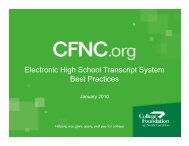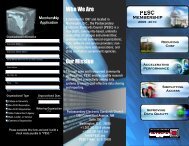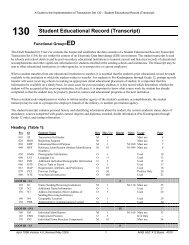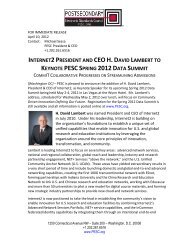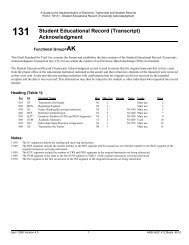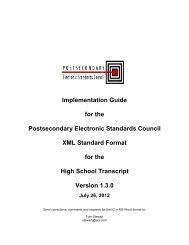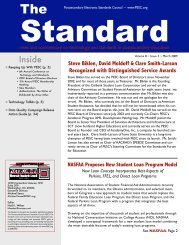February 2013 - PESC
February 2013 - PESC
February 2013 - PESC
You also want an ePaper? Increase the reach of your titles
YUMPU automatically turns print PDFs into web optimized ePapers that Google loves.
2012 Survey of Chief Information Officers 13<br />
prefer ERP vendor-provided systems that are tightly<br />
integrated and under the control of their institution<br />
as opposed to outsourced solutions. The majority of<br />
institutions will be planning for and/or implementing new<br />
systems in the next six years. This is to be expected<br />
as a follow-up wave to the pre-Y2K surge that caused<br />
many institutions to acquire new systems from 1995 to<br />
2000. Partnering with other institutions through shared<br />
services or collaboration agreements may provide some<br />
institutions with a cost-saving strategy. Although many<br />
institutions are interested in pursuing such strategies,<br />
few are actually doing so at this time. We also see<br />
a need to invest in mobile applications that are tied<br />
directly to administrative system data, such as student<br />
schedules, bill payments, and course grades. For<br />
students, these tools have already become a necessity<br />
as the mobile world continues to grow.<br />
Academic Computing<br />
This survey confirmed a number of trends dealing with<br />
teaching and learning, including the following:<br />
• Vendor dominance in the learning management or<br />
course-management system (CMS) market is being<br />
challenged by open-source applications such as<br />
Moodle and Sakai.<br />
• Central IT continued to provide the primary support<br />
for the CMS, though the number of respondents using<br />
shared services has increased.<br />
• The Office of the CIO or the Office of the Provost/<br />
Chief Academic Officer remained the primary source<br />
for instructional design, course design, and onlinelearning<br />
management (69%).<br />
• Most respondents continued to outsource student<br />
e-mail services (75%).<br />
• Institutions have strongly adopted desktop<br />
virtualization with a concomitant curtailing of<br />
the growth of student community labs; 25% of<br />
respondents use desktop virtualization to replace<br />
student community labs.<br />
A majority of institutions (59%) use a vendor-supplied<br />
CMS as the standard, while 30% use open-source<br />
solutions, 8% have an outsourced solution, and just 2%<br />
utilize a home-grown solution. Blackboard remains the<br />
dominant CMS vendor, with 45% of respondents using<br />
it as the institutional standard. Moodle was reported as<br />
the standard by 26%, and Desire2Learn was third with<br />
12%. Sakai and Angel (now owned by Blackboard) were<br />
reported as standards by 7% and 4% of respondents,<br />
respectively, and Instructure’s Canvas product was used<br />
by a few institutions (3%). However, the use of opensource<br />
solutions has been increasing since 2010 at the<br />
expense of vendor solutions.<br />
(Please note that our data are not intended to be used as<br />
marketing data for the use of CMS in higher education.<br />
Our sample size is global and large, but it is only meant to<br />
provide useful trend information and strategic and tactical<br />
support for CIOs in higher education.)<br />
CMS currently used as the institutional<br />
standard<br />
Just over half of the respondents (54%) have used their<br />
current CMS for longer than five years. Six percent of<br />
respondents are in the process of implementing their<br />
CMS, with the remainder (40%) having had their CMS for<br />
less than five years.<br />
The CMS market space is likely to be dynamic over<br />
the next several years, with approximately a third of<br />
the respondents falling into one of three categories:<br />
changing now or in two to three years; committing<br />
to their CMS for three years or more; or uncertain<br />
when they would consider a replacement. Only 37% of<br />
respondents planned to stay with their current CMS for<br />
more than 3 years (37%), 30% were not sure when they<br />
would replace their CMS, 19% were currently changing<br />
their CMS, and 17% were considering a switch in two to<br />
three years.<br />
A majority of respondents (63%) assign responsibility<br />
for the CMS and related infrastructure maintenance<br />
to the central IT unit, whereas 16% of the institutions<br />
outsource maintenance and 10% had a separate unit for<br />
online education maintaining the CMS. Finally, a small<br />
number of institutions had an academic computing group<br />
maintaining the CMS.<br />
Shared services appear to be gaining in the role of<br />
supporting a CMS. Of the respondents, 32% were<br />
considering establishing a service center and 16%<br />
have already implemented shared services to support<br />
a CMS. A similar number of institutions (46%) were not<br />
considering shared services. Seven percent were<br />
not sure.



